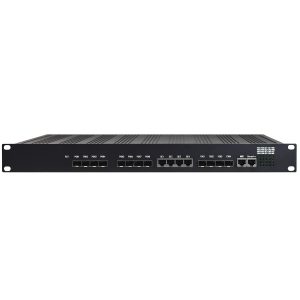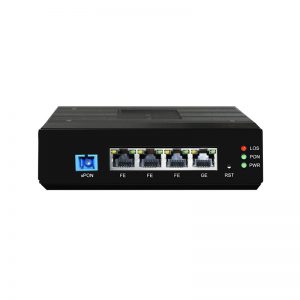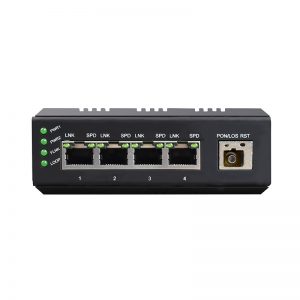Before understanding the difference between OLT, ONU/ONT, and ODN, we need to understand what PON is first. The PON (Passive Optical Network) is a fiber optic network that uses point-to-multipoint topology and fiber splitters to carry data from a single transmission point to multiple user endpoints. In contrast to AON, various customers are connected to a single transceiver via fiber branch trees and passive splitter/combiner units, operating entirely in the optical domain and requiring no power supply in PON architecture. At present, there are two primary PON standards: GPON (Gigabit Passive Optical Network) and EPON (Ethernet Passive Optical Network).
Structure and Components of PON
In a PON system, there is an OLT (optical line terminal) at the service provider’s central office and multiple ONUs (optical network units), which are also known as ONTs (optical network terminals) near end users, as well as a fiber optic splitter.
OLT (Optical Line Terminal)
Definition
OLT is a device that basically acts as a part of a PON (Passive Optical Network) system. It is located at the central office of the network and manages the transmission and reception of information across the entire network. OLT does this by converting electrical signals into optical signals (and vice versa) to ensure the correct flow of information. Typically, OLT can be used to send and receive information over a distance of up to 20 kilometers.
OLT Device Components
Typically, OLT equipment consists of several components including a rack, CSM (Control and Switch Module), ELM (EPON Link Module or PON card), redundancy protection -48V DC power supply modules (or a single 110/220V AC power supply module), and fans. Among these parts, the PON card and power supply modules support hot-swapping, allowing them to be replaced without powering down the OLT. The other modules are built-in and not designed for hot-swapping.
The OLT operates in two directions: upstream and downstream. In the upstream direction, it receives and distributes various types of data and voice traffic from users. In the downstream direction, it receives data, voice, and video traffic from the metro network or long-haul network and transmits it to all ONT modules on the ODN (Optical Distribution Network). This ensures that the data, voice, and video traffic reaches the respective ONTs connected to the OLT.
OLT Functions
The OLT device serves as crucial central office equipment in EPON, functioning as a versatile platform for delivering multiple services simultaneously, including IP services and traditional TDM services. It is strategically positioned at the periphery of the MAN or community access network exit to consolidate access services and subsequently transmit them to the IP network.
The EPON passive optical network system presents remarkable flexibility, as it interconnects multiple terminals located within a 20-kilometer radius at service access points, forming an extensive EPON network. This system supports various business models, accommodates diverse operational environments, and offers users a comprehensive range of FTTx series solutions.
Apart from its service aggregation capabilities, the OLT also serves as a centralized network management platform. It enables device-based network element management, as well as service-oriented security management and configuration management. The OLT facilitates the monitoring and administration of devices and ports, provisioning of services, and monitoring of user statuses, and it can allocate bandwidth based on the specific QoS/SLA requirements of individual users.
1. Facilitate the transmission of Ethernet data to ONU in broadcast mode.
2. Initiate and regulate the ranging process, while recording relevant ranging information.
3. Allocate bandwidth for ONU, including controlling the initiation time for data transmission and the size of the transmission window.
OLT Application
The OLT device collaborates with different types of ONU to establish diverse access networks, including FTTC, FTTH, FTTO, FTTM, and more. On one hand, it aggregates signals carrying various services at the central office and transmits them to end users within the access network using a specific signal format. On the other hand, it forwards signals from end users to different service networks based on the type of service.
In the diagram below, we can observe an FTTH application. The OLT is interconnected with the management switch and ONU. A splitter is placed between the OLT and ONU. The entire PON (Passive Optical Network) enables multiple households to access numerous services such as IPTV, VOIP, IP Camera, and more.
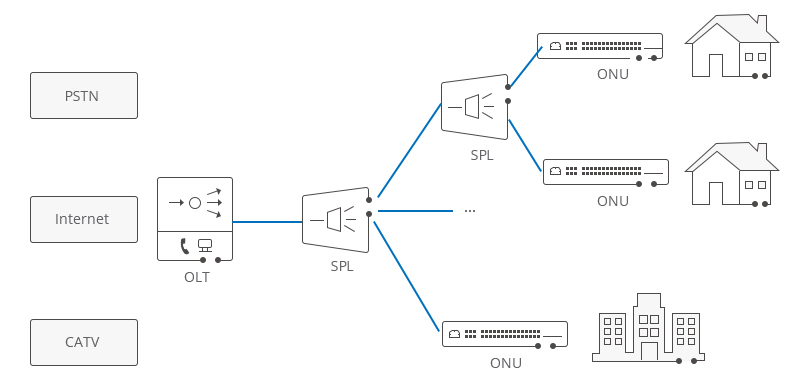
ONU (Optical Network Unit)/ONT (Optical Network Terminal)
The ONU translates optical signals transmitted through fiber optics into electrical signals. These electrical signals are then transmitted to individual subscribers. Typically, there is a distance or another type of access network between the ONU and the end user’s premises. Additionally, the ONU can transmit, combine, and optimize various types of data received from customers, sending it upstream to the OLT. Optimization involves reorganizing the data stream to enhance delivery efficiency. The OLT supports bandwidth allocation, ensuring a smooth delivery of data packets to the OLT, which typically arrive in bursts from the customer. The ONU can be connected using different methods and cable types, such as twisted-pair copper wire, coaxial cable, optical fiber, or Wi-Fi. The end-user devices can also be referred to as optical network terminals (ONTs). The ONT is essentially the same as the ONU. The term ONT is used by the ITU-T, while ONU is an IEEE term. Despite belonging to different standard bodies, both terms refer to the user-side equipment in the EPON system. However, in practice, there may be slight differences in the usage of ONT and ONU based on their respective locations.

ODN (Optical Distribution Network)
The ODN plays a crucial role in the PON system, serving as the optical transmission medium for connecting the ONUs to the OLTs over distances of 20 km or greater. In the ODN, various components such as fiber optic cables, fiber optic connectors, passive optical splitters, and auxiliary elements work together in collaboration. The ODN consists of five distinct segments, including the feeder fiber, optical distribution point, distribution fiber, optical access point, and drop fiber. The feeder fiber originates from the ODF (optical distribution frame) located in the central office telecommunications room and extends to the optical distribution point, providing long-distance coverage. The distribution fiber runs from the optical distribution point to the optical access point, distributing optical fibers to adjacent areas. The drop fiber connects the optical access point to the terminals (ONUs), enabling optical fiber connectivity to user residences. Moreover, the ODN serves as the critical pathway for PON data transmission, and its quality directly impacts the performance, reliability, and scalability of the PON system.
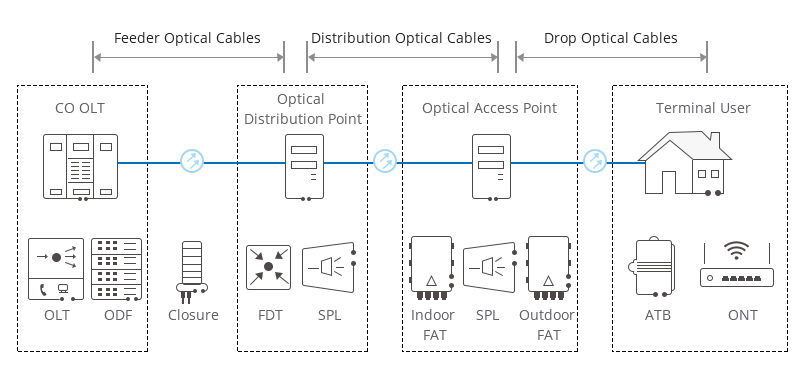
Summary
The Optical Line Terminal (OLT), Optical Network Unit (ONU) or Optical Network Terminal (ONT), and Optical Distribution Network (ODN) constitute the key components of a Gigabit Ethernet Passive Optical Network (GEPON) system, which has gained widespread adoption in Fiber-to-the-Home (FTTH) applications. The use of passive optical networks offers several advantages, such as reduced cabling infrastructure (without active elements) and flexible media transmission, making them highly suitable for delivering home Internet, voice, and video services. Furthermore, passive optical networks find applications in various settings, including college campuses and business environments, where they provide cost-effective solutions. With continuous advancements in PON technology, the range of potential applications has also expanded significantly.
You may be interested:
8 PON Port EPON OLT (Uplink: 4*GE + 4*10G SFP+)
Industrial 1-Port GE + 3-Port FE EPON/GPON (XPON) ONU
Industrial 4-Port GE EPON/GPON (XPON) ONU With POE


